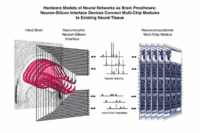In this era of high-tech memory management, next in line to get that memory upgrade isn't your computer, it's you.
Professor Theodore W. Berger , director of the Center for Neural Engineering at the University of Southern California, is creating a silicon chip implant that mimics the hippocampus, an area of the brain known for creating memories. If successful, the artificial brain prosthesis could replace its biological counterpart, enabling people who suffer from memory disorders to regain the ability to store new memories.
And it's no longer a question of "if" but "when." The six teams involved in the multi-laboratory effort, including USC, the University of Kentucky and Wake Forest University, have been working together on different components of the neural prosthetic for nearly a decade. They will present the results of their efforts at the Society for Neuroscience 's annual meeting in San Diego, which begins Saturday.
While they haven't tested the microchip in live rats yet, their research using slices of rat brain indicates the chip functions with 95 percent accuracy. It's a result that's got the scientific community excited.
"It's a new direction in neural prosthesis," said Howard Eichenbaum , director of the Laboratory of Cognitive Neurobiology at Boston University. "The Berger enterprise is ambitious, aiming to provide a prosthesis for memory. The need is high, because of the prevalence of memory disorder in aging and disease associated with loss of function in the hippocampus."
Forming new long-term memories may involve such tasks as learning to recognize a new face, or remembering a telephone number or directions to a new location. Success depend on the proper functioning of the hippocampus. While this part of the brain doesn't store long-term memories, it re-encodes short-term memory so it can be stored as long-term memory.
It's the area that's often damaged as a result of head trauma, stroke, epilepsy and neurodegenerative disorders such as Alzheimer's disease. Currently, no clinically recognized treatments exist for a damaged hippocampus and the accompanying memory disorders.
Berger's team began its research by studying the re-encoding process performed by neurons in slices of rat hippocampi kept alive in nutrients. By stimulating these neurons with randomly generated computer signals and studying the output patterns, the group determined a set of mathematical functions that transformed any given arbitrary input pattern in the same manner that the biological neurons do. And according to the researchers, that's the key to the whole issue.
"It's an impossible task to figure out what your grandmother looks like and how I would encode that," said Berger. "We all do a lot of different things, so we can't create a table of all the things we can possibly look at and how it's encoded in the hippocampus. What we can do is ask, 'What kind of transformation does the hippocampus perform?'
"If you can figure out how the inputs are transformed, then you do have a prosthesis. Then I could put that into somebody's brain to replace it, and I don't care what they look at -- I've replaced the damaged hippocampus with the electronic one, and it's going to transform inputs into outputs just like the cells of the biological hippocampus."
Dr. John J. Granacki , director of the Advanced Systems Division at USC, has been working on translating these mathematical functions onto a microchip. The resulting chip is meant to simulate the processing of biological neurons in the slice of rat hippocampus: accepting electrical impulses, processing them and then sending on the transformed signals. The researchers say the microchip is doing exactly that, with a stunning 95 percent accuracy rate.
"If you were looking at the output right now, you wouldn't be able to tell the difference between the biological hippocampus and the microchip hippocampus," Berger said. "It looks like it's working."
The team next plans to work with live rats that are moving around and learning, and will study monkeys later. The researchers will investigate drugs or other means that could temporarily deactivate the biological hippocampus, and implant the microchip on the animal's head, with electrodes into its brain.
"We will attempt to adapt the artificial hippocampus to the live animal and then show that the animal's performance -- dependent in these tasks on an intact hippocampus -- will not be compromised when the device is in place and we temporarily interrupt the normal function of the hippocampus," said Sam A. Deadwyler , "thus allowing the neuro-prosthetic device to take over that normal function." Deadwyler, a professor at Wake Forest University, is working on measuring the hippocampal neuron activity in live rats and monkeys.
The team expects it will take two to three years to develop the mathematical models for the hippocampus of a live, active rat and translate them onto a microchip, and seven or eight years for a monkey. They hope to apply this approach to clinical applications within 10 years. If everything goes well, they anticipate seeing an artificial human hippocampus, potentially usable for a variety of clinical disorders, in 15 years.
Overall, experts find the results promising.
"We are nowhere near applicability," said Boston University's Eichenbaum. "But the next decade will prove whether this strategy is truly feasible."
"There is a big gap in making the microchip work in a slice preparation and getting it to work in a human being," added Norbert Fortin, a neuroscientist from the Cognitive Neurobiology Lab at Boston University. "However, their approach is very methodical, and it is not unreasonable to think that in 15 to 20 years such a chip could help, to some degree, a patient who suffered from hippocampal damage."
Research Group, Wired Link




No comments:
Post a Comment